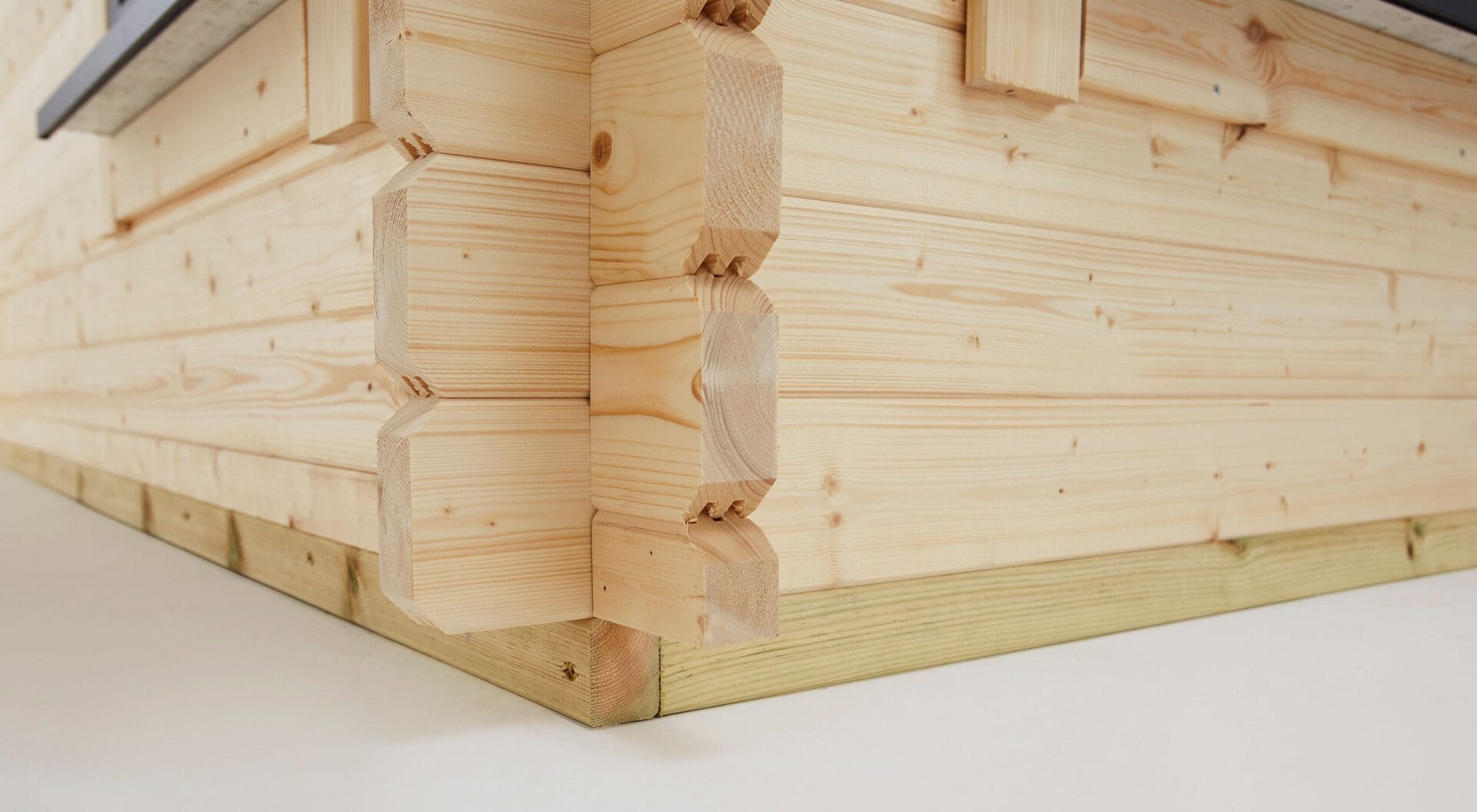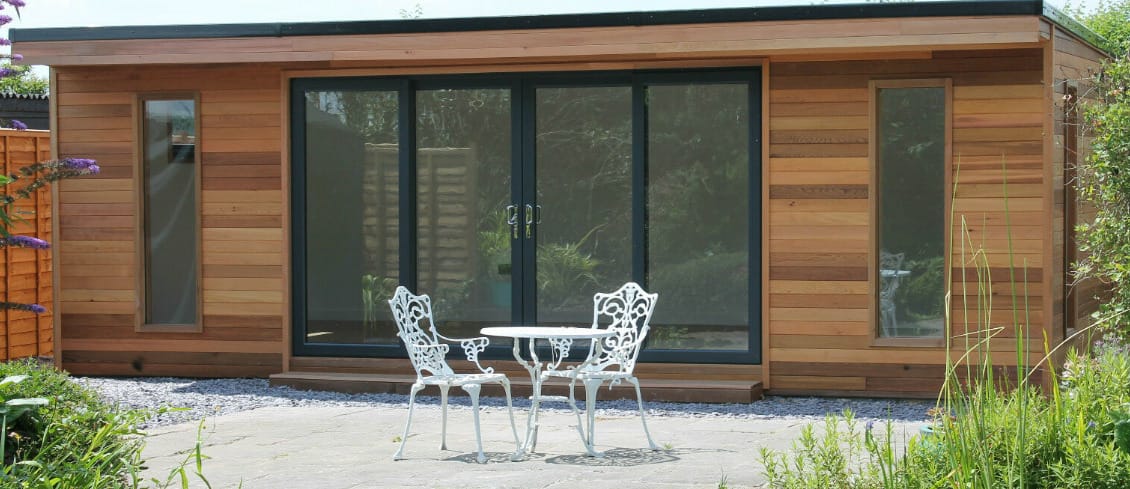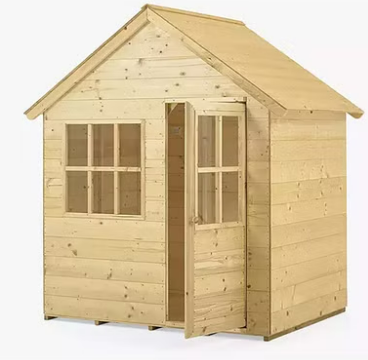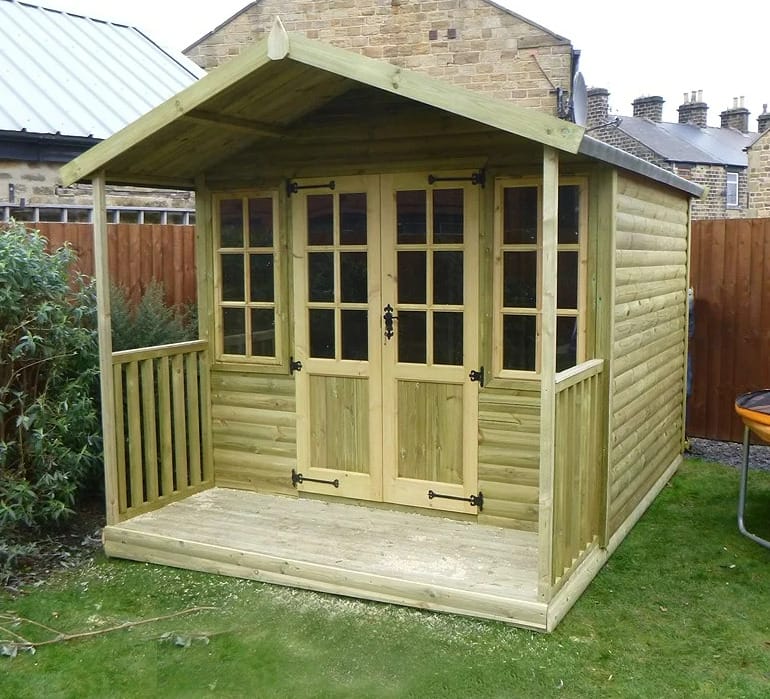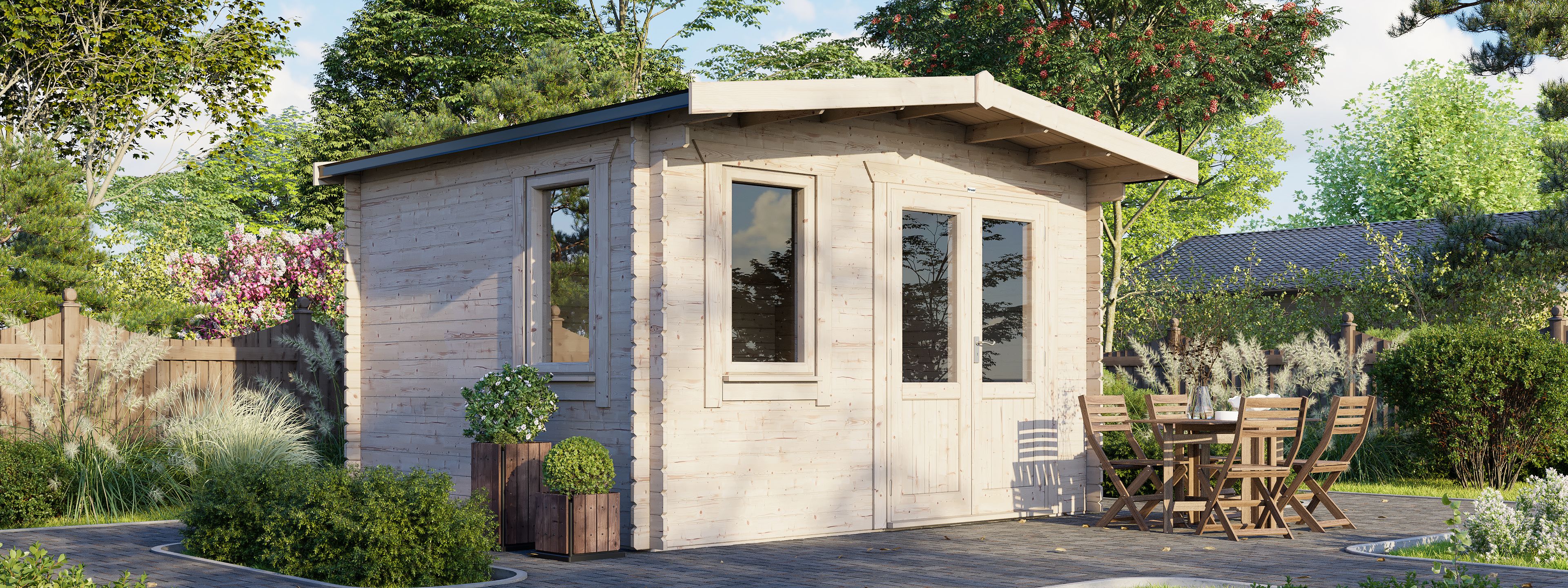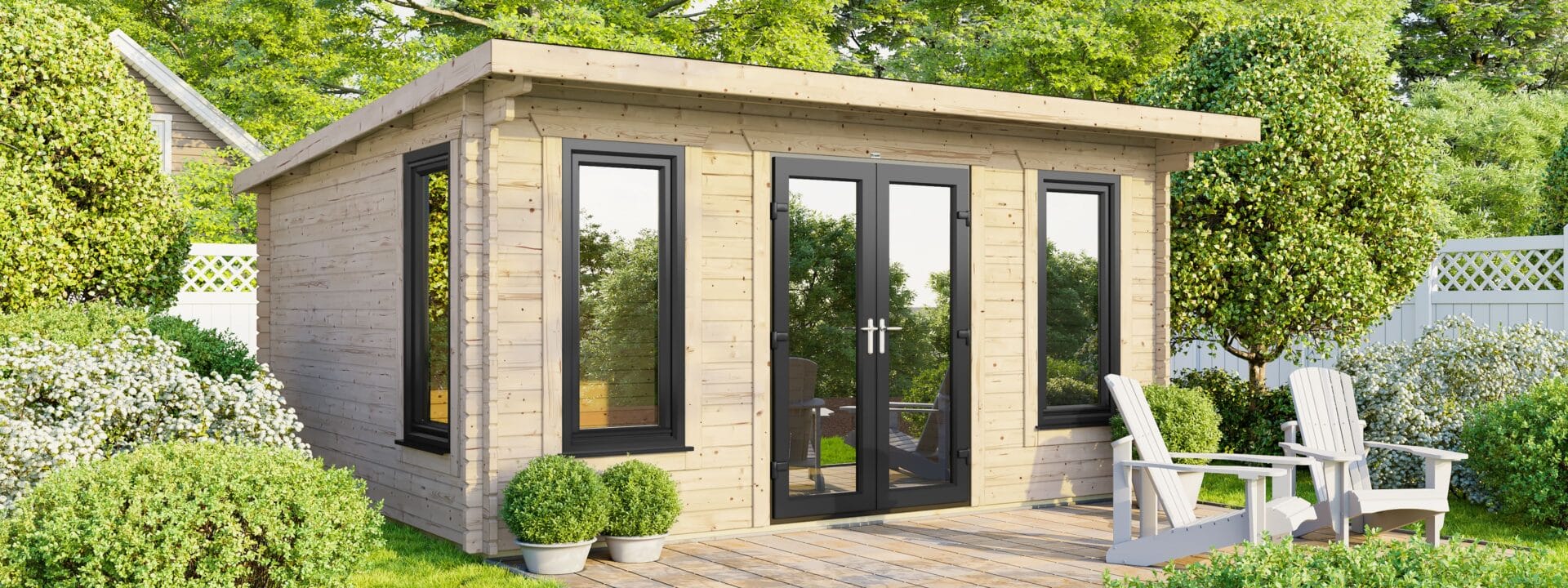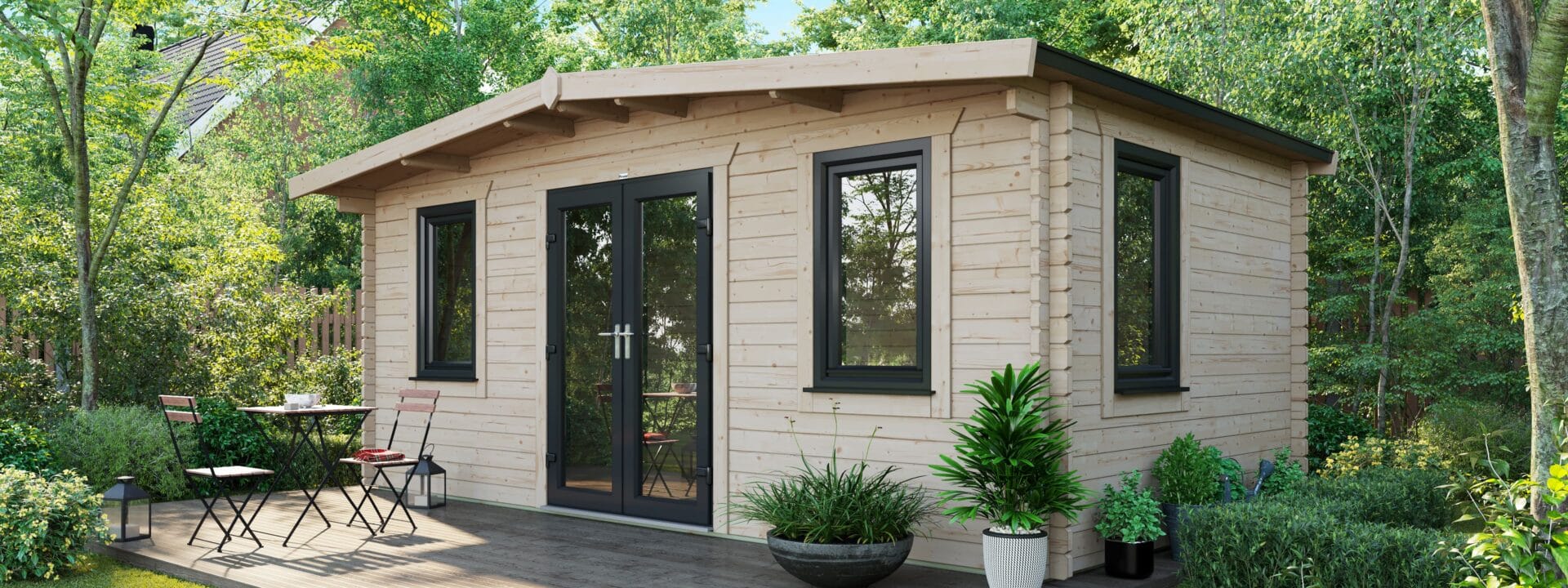Guide to Buying a Log Cabin
Log cabins are becoming increasingly popular because they are a simple, cost effective way to expand your space, that look great. They transform the look of your garden and give you extra living space for an office, gym, or cosy retreat. There is a lot to consider when buying a new log cabin though; you need to think about everything from size and style through to installation and delivery.
This log cabin buying guide uses a step-by-step approach to ensure you have all the information you need before making a purchase. We cover the following topics:
- Sizes
- Cladding
- Roof and floor
- Windows and door
- Layout and style
- Bases
- Electricity & Wi-Fi
- Installation
- Planning permission
- Delivery
Choosing a size
The log cabin size you need depends on what you want to use it for and the space you have available.
How much space do you have?
Your garden only has so much room, so you need to make sure you buy a log cabin that fits nicely in your outdoor space. When measuring your garden, you should leave 1-2ft of space around it for maintenance. You should also leave space for windows and doors to open properly.
What are you using the log cabin for?
We recommend you also consider what you’re going to be using your log cabin for. If you want to use it for a home office, think about the space you’ll need for a desk, chair and storage options.
Do you want to use it to entertain friends or as an additional family room? You will need a log cabin big enough for comfy sofas, bean bags and storage.
We have a range of sizes available on our website with images and dimensions.
You can shop for log cabins by sizes below:
Cladding
Log cabin cladding construction is also something you should think about before buying your log cabin. There are many different options available, but it’s likely your log cabin will be built using tongue and groove cladding or solid logs.
Tongue and groove cladding
This features one or two grooves or slots at one end, and one or two tongues at the other. The tongue of one board of timber fits into the groove of another identical one – this is repeated until it forms a panel. Using tongue and groove cladding has several benefits, it’s strong making it more secure and weather resistant, and the seamless design gives it an attractive appearance.
Solid log construction
This is a common look for log cabins and involves using logs that have not been milled into conventional lumber. These logs are stacked horizontally and interlocked using their end notches. It provides a strong, sturdy frame and a natural look that has many different styles and options.
Why is cladding thickness important?
A standard shed will have 8-12mm cladding, but log cabins usually start at 19mm. Here is why it’s important to consider cladding thickness:
Thermal insulation – The thicker the cladding, the better the thermal insulation. If you want your log cabin to be warm all year round, you should look for cladding between 44 and 70mm.
Weather resistance – In extreme conditions, sheds, log cabins and summer houses with thin cladding can become damaged. With thick cladding, your log cabin will stand strong against the elements.
Noise – This could be an important factor if you plan to use the log cabin for a home office or an extension to the house. Thick cladding will block out noise and allow you to work or relax in peace.
Security – It can be easy to break into a building with 8mm overlapping cladding, but a 44mm+ tongue and groove log cabin is completely different.
Shelving – You need to consider cladding thickness if you plan on fixing shelving and storage inside. The wood on the outside will need to support the weight of whatever you plan on storing on the inside.
Appearance – Cladding thickness can play a part in appearance too. Log cabins built with tongue and groove cladding, or solid wood have a natural, solid look.
Roofing
Next up, you should think about your roof. Your choice of roof and roof covering influences the strength, insulation, and appearance of your new log cabin. When it comes to design, you have a few options available:
Roof Design
Apex roof
This is a traditional look for a log cabin roof that allows for more headspace in the centre of the building. Apex roofs also have overhang to protect the building from rainfall. You should be careful not to install your apex log cabin too close to the boundary fence or it could lead to rainwater pouring into your neighbour’s garden.
Pent roof
A pent roof gives a modern look to your log cabin. The roof typically slopes backwards allowing for more headspace at the entrance, although this can be changed at your request so the entrance can be at the lower side. This design can also make it easier to sit under trees or along a fence line.
Reverse apex roof
This design has the traditional look of an apex roof but the doors are placed on the longer side, not a gable end, giving you the increased entry headroom you’d get with a pent. This may be better suited for you depending on the interior layout.
Roof Covering
Roof coverings give you a range of different looks for your log cabin and can also be important for weatherproofing. Here are the three most popular options:
Felt
This is probably the most common type of roof covering for log cabins. The economic option is black sand felt which lasts around 5 years. Polyester- blacked felt has additional fibre support that makes it more durable and is an option with a longer lifespan of 15-25 years.
Underlay
Other roofing options include underlay, wooden slats, and cedar shingles. Underlay lengthens the lifespan of the felt and offers more protection against the weather.
Felt shingles
Felt shingles are available with some log cabins. They’re rectangular or hexagonal in design and provide an attractive finish. Similar in durability to a felt roof, they protect the log cabin from rain and other elements.
EPDM Roof Covering
This type roof material is designed to protect the building from all kinds of weather and has a life expectancy of approximately 50 years. It’s a popular option for log cabins as well as home extensions, due to it’s resilience and versatility.
Windows and Doors
Customising your windows and doors gives your log cabin the perfect look, but also influences how much sunlight gets in which can be beneficial depending on what you want to use it for. The size and type of door can also restrict what items you can bring in and out of your log cabin. If you plan on moving sofas and gym equipment in, a double door might be a smart choice.
Window and door styles
Full Pane:
Euro Style:
Georgian Style:
Half Boarded:
uPVC:
Double glazing and toughened glass are often available as upgrades and provide additional benefits like heat retention and increased security. It’s also worth checking if you have selected opening windows if you plan on letting in a cool summer breeze.
Base for a log cabin
There are some important things you need to remember when installing the base for a new log cabin. First, a log cabin should be built on a level, strong surface. An inferior base leads to structural shifting, issues with doors and windows, and cracking. If you’re using an existing base, take time to ensure the concrete or slabs are level and reliable.
If your new base is on grass, you should take care to remove rocks, tree roots and other obstructions so the ground is suitably level. You should also use a damp-proof membrane to protect your log cabin base from water damage.
Plastic bases are becoming increasingly popular because they provide a light, eco-friendly option that is both durable and strong. They also come with a membrane, so you don’t need to worry about damp. If you’re installing a larger log cabin, you should fill a plastic shed base with gravel for extra stability.
Do I need planning permission?
Most garden buildings do not require planning permission, but it’s recommended you check with your local council before buying a log cabin. However, permission is required under any of the following circumstances:
- Log cabin is not for domestic use
- It has internal dimensions over 30m2
- It will be sited to the front of the property’s principal elevation
- It is over 3m high with a pent roof
- It is over 4m high with an apex roof
- It is within 2m of the property boundary
- It will result in over half of the property’s land being covered
If the above criteria are met, you should not need permission from the council. We do recommend making your neighbours aware you’re installing a log cabin as not informing them of any construction projects on your property could potentially lead to issues down the line.
Installing my log cabin
We have mentioned the importance of properly preparing a base for your log cabin, but there are a few more things you should remember before installation.
You should look to install your new log cabin at least 18 inches from the nearest boundary fence or wall to leave room for painting or maintenance.
Repeated walking to and from your log cabin could also damage your grass, it wouldn’t be a bad idea to consider installing your log cabin near an existing path or building a new walkway.
A water based adhesive is provided for the EPDM roof covering. Installation of the EPDM is also weather dependant, requiring the timber to be dry and the temperature to be +5ºC with the maximum humidity being 80%. If installing in temperatured under 10ºC, you may require a solvent based adhesive which you would need to purchase yourself.
Most companies will offer an installation service as an additional charge. You can do it yourself, but it can be time consuming and will require basic DIY capability. If you’re feeling determined, you should be aware that installing a log cabin is usually a two-person task even if you have strong DIY skills. This is because of the weight of various components involved. An instruction manual will be provided when your log cabin is delivered, there are also videos available that can support with construction.
Delivery information
Your log cabin will be delivered on an 26t HIAB (approx. 10.7 long and 2.6m wide) vehicle by a third-party courier, using a crane which is positioned behind the cab on the vehicle. If there are any access restrictions for a vehicle of this size, please let us know as soon as possible.
The driver will unload the cabin pack using the crane and leave it as close to your desired location as possible. This will usually be a driveway; however, we do sometimes get requests for deliveries over fences and gates. The driver will do this if it’s possible, but if there isn’t sufficient reach with the crane it will delivered somewhere more accessible.
We request there is someone there upon delivery. Having someone with knowledge of the property to advise the driver where to leave the pack is very useful. After you have bought your new log cabin, we will get in touch to book in a suitable delivery time and give you an approximate time your order will arrive.
Contacting Us
Our friendly customer service team are happy to answer any of your questions. You can get in touch on 01274 036577, we are open 8am – 4.30pm Mon-Fri. You can also email us on hello@powersheds.com or submit a customer enquiry here.

